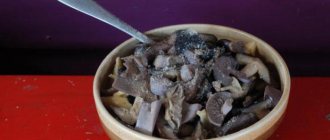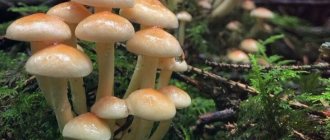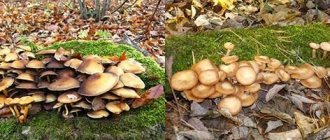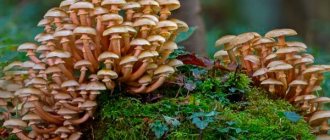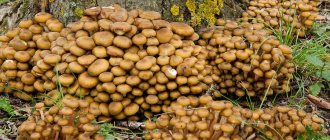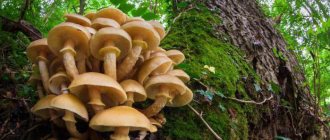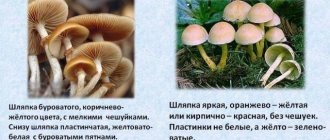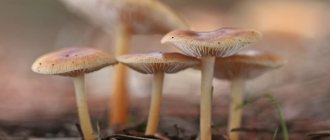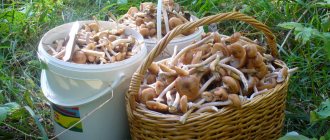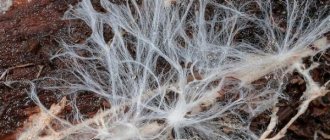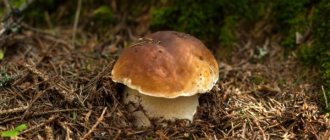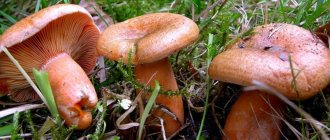Often, even experienced mushroom hunters confuse mushrooms that are suitable and those that are unsuitable for food, but even beginners who do not understand the subtle differences between each name go looking for them. The article you are looking for describes the signs of poisoning with false honey mushrooms, which appear in people who have eaten false honey mushrooms. It is imperative to know them in order to determine in time what happened and seek medical help.
Honey mushrooms are one of the most desirable prey for mushroom pickers.
Honey mushrooms are one of the most delicious mushrooms, very popular among residents of Russia and other countries. Festive tables are often decorated with bowls of these creamy-brown mushrooms. They are fried and added to soups, salads and other traditional Russian dishes.
These wonderful mushrooms are sold frozen, and sometimes even fresh, in almost every supermarket today. However, their cost can scare off even the most ardent gourmet. On the one hand, it is justified, because the mushrooms were grown especially for you, collected, cleaned of contaminants, frozen and placed in neat packaging. However, as residents of the post-Soviet space say, saving should be economical, therefore, we proudly walk past refrigerated chests filled with mushrooms and go into the forest.
Mushroom picking is a traditional activity in our country and many others. However, seasonal visits to the forests always border on some danger, which consists in collecting inedible mushrooms.
Honey mushrooms are one of the most desirable prey for mushroom pickers. In the case of them, the danger increases several times, because, having aimed at collecting them, you can put in the basket not just an incomprehensible toadstool, which is simply thrown out when inspecting the prey at home. The fact is that honey mushrooms have, so to speak, twin brothers, called false honey mushrooms.
Preventive measures
To prevent poisoning from edible mushrooms, it is necessary to carefully select places for collecting mushrooms. Forests or fields are not suitable if there are:
Read also: Poisoning of the body with organophosphorus compounds
- railways,
- highways,
- industrial enterprises.
It is also prohibited to collect mushrooms in large cities, where the concentration of exhaust gases, and therefore lead compounds, in the air is always high.
It is not recommended to buy mushrooms from strangers. Honey mushrooms are also not purchased if the integrity of their stem or cap is damaged, since it is in the mushroom debris that pieces of fly agarics or pale toadstools most often end up undetected.
When preparing honey mushrooms, you need to remember the basic rules. To avoid poisoning from salted mushrooms, they are soaked for at least three days, changing the water every three hours. Heat treatment of honey mushrooms should last at least 30 minutes. It is strictly forbidden to store mushrooms in dishes made of clay or aluminum, as well as in galvanized pans.
Have you ever had honey mushroom poisoning?
- Yes it was
- No, it was not
- There are symptoms now
- I don't eat mushrooms
ResultsPoll Options are limited because JavaScript is disabled in your browser.
- No, there were no 76%, 128 votes 128 votes 76% 128 votes - 76% of all votes
- Yes, there were 15%, 25 votes 25 votes 15% 25 votes - 15% of all votes
- Currently have symptoms 7%, 12 votes 12 votes 7% 12 votes - 7% of all votes
- I don't eat mushrooms 2%, 4 votes 4 votes 2% 4 votes - 2% of all votes
Total votes: 169 08/08/2017 You or from your IP have already voted. Vote
- Yes it was
- No, it was not
- There are symptoms now
- I don't eat mushrooms
You or from your IP have already voted. results
How to distinguish a false or real honey fungus in front of you
When searching for mushrooms in local forests, as well as purchasing delicious specimens collected from sellers standing in the market and sitting next to the highway, you need to pay close attention to some of the visual characteristics of the mushrooms that appear before you. Let's look at the following table to see what features are characteristic of each category.
Table 1. Signs of false mushrooms
| Honey mushrooms of false category | Honey mushrooms are real | |
| External differences and taste |
|
|
As you can see, there are actually few significant differences. It is very important to pay attention to such little things as dark plates and a skirt, since at the stage when you feel the bitter taste, the harmful poisons of the honey fungus will already be inside your body.
In addition, if you made, for example, fried mushrooms, and it contained not only honey mushrooms, or, say, you used them in soup, it is quite difficult to feel their taste. In addition, when chopped and cooked, it will be extremely difficult to distinguish them from other ingredients, and you may think that you simply overcooked the vegetables in a frying pan.
Kinds
Honey mushrooms are divided into several types: winter, spring, summer and autumn. Everyone has their own false types.
Winter honey mushrooms
The type of winter honey fungus or velvety-footed flammulina differs from other varieties in the time of harvest. It begins in mid-autumn and can continue throughout the winter.
Winter honey mushrooms (flammulina) grow on the stumps of birch and oak trees. They have a hemispherical, honey-yellow cap. In conditions of high humidity, its surface becomes slimy.
The flesh is cream colored. There are no scales or rings on the leg.
This type is tasty and valuable among honey mushroom lovers, although not everyone likes the fact that they become slimy during cooking. In addition, this species is suitable for cultivation at home.
Winter mushrooms grown at home are not inferior in taste to their forest counterparts and are absolutely safe.
Spring honey mushrooms
One of the most popular species with which meadow honey mushrooms are often confused is the wood-loving collibia. Her cap is hygrophanic, creamy-brown, with a light edging. The mushroom grows in pine and spruce forests. The pulp tastes hard, so wood-loving collibia is not in great demand among mushroom pickers.
Another popular variety is the white slimy mushroom. It grows on tree bark and dead wood. Its cap is snow-white and slimy in any weather. The variety has a ring on the stem and is completely covered with scales.
Spring varieties do not have much nutritional value, so they are rarely used in cooking.
Summer honey mushrooms
Summer honey mushrooms bear fruit from May to early September. The mushrooms are edible, their caps are hemispherical, light and dark brown in color with a watery surface. The leg is dense and hard, its length is usually 3-7 cm, the color is yellow-brown with a pronounced white belt in the middle.
These mushrooms grow on trees, soil, and stumps. They have excellent taste and aroma and are widely used in cooking. The disadvantage is that they have many false representatives.
Autumn honey mushrooms
False autumn mushrooms differ from previously described species in their larger dimensions. At maturity, the caps reach about 11 cm in diameter. Surface color is gray-yellow, light brown. There is a pronounced ring on the stem. Young mushrooms have a scaly surface. As it grows it becomes smooth.
White spores of autumn honey mushrooms often fall from the hymenophore plates of mushrooms located in the upper tier onto the surface of mushroom caps from the lower tier, so in overripe specimens the surface of the cap often looks moldy. As the plates grow, they change color from light yellow to light brown. Real autumn mushrooms taste good.
You can recognize autumn mushrooms from others by their slight glow at night.
Irina Selyutina (Biologist):
Autumn honey fungus is also called “true honey fungus,” which includes two species that are practically twins in appearance. They can be distinguished only by microscopic examination of the hymenium - this makes it possible to examine the presence of a buckle at the base of the basidia of the northern honey fungus species. It is absent in the honey mushroom. And if we take it by its distribution area, then we can say that the northern honey mushroom justifies its name - it is confined to the northern regions of Russia, in contrast to Fr. honey, which is found in the southern regions. But temperate latitudes are characterized by the presence of representatives of both species in conditions suitable for them.
Autumn hemp mushrooms grow near log houses of pines, spruces, birches, along the diameter of aspen and oak stumps. You can also find them on the trunks of bushes, trees, and even next to herbaceous plants. The autumn ones have 2 false twins, which are very similar in appearance and smell.
Symptoms of poisoning with false honey mushrooms
After the false honey fungus gets into your mouth and its toxic substances are absorbed by the walls of your intestines, after some time the symptoms of intoxication will begin to appear.
Unfortunately, all sensations that arise must be classified as insignificant. People simply don’t pay attention to them; in most cases, only hypochondriacs tend to notice every change.
The time it takes for symptoms to appear is 20 minutes from the moment the mushrooms are eaten. The patient may feel:
- pain in the stomach, not strong enough to cause panic;
- rumbling in the abdominal cavity;
- heartburn occurs;
- your head starts to feel dizzy;
- all the above symptoms are accompanied by nausea.
Depending on how strong your body is, such mild manifestations will continue to bother you for a period of two to six hours.
After the above-mentioned time has elapsed, the second phase of poisoning begins, accompanied by increasing symptoms of intoxication.
All of the above symptoms progress and new ones are added to them, for example:
- apathy;
- severe weakness;
- drowsiness and lethargy;
- trembling of limbs.
Nausea turns into vomiting, as the body tries to cope with the poisoning by expelling harmful toxins. To cleanse the toxic substances that have already penetrated into the intestines, loose stools open. Acts of defecation become frequent, the consistency of stool is watery.
In addition to all the uncomfortable symptoms listed above, there is a sharp, cutting pain in the peritoneum that forms in the stomach. The person's skin becomes covered with cold sweat, the patient's legs and palms become especially wet. The level of sugar in the main biological fluid of a person is rapidly falling.
Please note this important tip. Since vomiting and diarrhea remove fluid from the body, it is necessary to give the poisoned person something to drink, preferably plain water. In addition, it is important to quickly find your bearings and remember that he recently ate mushrooms in order to go to the hospital without losing precious time.
Effect on various body systems
Despite the fact that the toxin released by false mushrooms causes a serious blow to the gastrointestinal tract, the following organs of the human body receive an even stronger negative effect from it:
- the heart, and with it all the blood vessels;
- the brain and the entire nervous system of the body.
Cardiac activity is depressed, after the intake and absorption of false poison, arrhythmia occurs again, the pulse becomes very rare. The pressure in the arteries begins to decrease, if a lot of mushrooms have been eaten, the situation can reach a critical decrease, immediately before the onset of collapse. There is no longer enough oxygen, as a result of which the patient’s skin and mucous membranes acquire a bluish tint. Dizziness also seriously increases, the head begins to pound at the same time, and the person becomes drowsy.
If the victim does not immediately receive qualified medical assistance at this stage, then soon he will begin to imagine different things and become delusional. Incoherent images – various kinds of hallucinations – will begin to flash before the eyes of the patient who has received the message. In this state, a person is in a state of insanity, accompanied by either excited or apathetic behavior.
In addition, during poisoning with false honey mushrooms, various processes in the body can be disrupted and kidney failure can develop. The chemical balance of the body's environment is seriously shifted. This happens due to the onset of diarrhea and frequent vomiting, since the liquid substances leaving a person take all the water, leading to dehydration. This condition is extremely dangerous, and it is accompanied by its own symptoms.
When dehydration is mild, it feels like this:
- the oral cavity dries out;
- thirst appears;
- when visiting the toilet, the patient observes that he produces less urine; if the poisoning reaches an extreme degree, urine production may stop completely;
- saliva in the mouth becomes viscous or disappears completely;
- mucous membranes become dry, the same happens to the skin;
- severe shortness of breath appears;
- Often people faint.
If dehydration reaches a serious degree, acute renal failure develops.
The poison of false mushrooms also has an effect on the liver. After the mushrooms are digested in the stomach and pass into the intestines, the substances contained in them will be absorbed by the walls of the organ in order to be transported through the blood to all other elements of the human body system.
In addition to the heart and brain, the poison strongly affects the liver, as a result of which jaundice of the mucous membranes and skin of the body instantly appears. The liver increases in size, severe pain begins in the right hypochondrium and heaviness develops. There is a bitter taste in the mouth, and there is a specific, unpleasant odor coming from the cavity. It is quite possible to diagnose mushroom poisoning based on these symptoms, especially if you conduct an additional study - blood biochemistry, the results of which will help determine:
- whether bilirubin is increased;
- Is there an increase in liver enzymes?
It is very important to keep in mind that all of the listed symptoms develop at the moment when necrotic processes start inside the liver. Ignoring them will lead to liver failure. As you know, it is this organ that is responsible for cleansing the blood of toxins, which means that intoxication will become even greater than it was before.
Conditionally edible mushrooms
Honey mushrooms belong to the category of conditionally edible mushrooms, that is, those that under no circumstances should be eaten raw. Before eating conditionally edible mushrooms, they should be subjected to heat treatment. Moreover, it is necessary to cook honey mushrooms in two steps. First boil in one water, and then drain the broth and pour fresh water over the mushrooms. You need to cook honey mushrooms for at least half an hour. Otherwise, these mushrooms can cause poisoning.
However, even after appropriate treatment, honey mushrooms can cause diarrhea. In Austria, these mushrooms are even used as a natural laxative. That is why honey mushrooms should not be carried away by those who are prone to stomach upsets or suffer from other disorders of the gastrointestinal tract.
Regular abuse of honey mushrooms also negatively affects the pancreas and can lead to pancreatitis.
Honey mushrooms are contraindicated for preschool children, pregnant and lactating women, as well as people with a history of kidney disease, heart disease and hypertension.
First aid for poisoning with false mushrooms
The first responder's goal is to prevent the toxins from spreading further throughout the body. This is necessary to protect the organs that have not yet been affected, and to prevent further destruction in the rest.
Unfortunately, it is difficult to carry out a fairly effective procedure at home; this can only be done in a medical facility, by lavaging the stomach using a special probe. However, you can try to influence the situation at home using the following methods.
- First of all, you need to cleanse the stomach yourself, using the natural mechanism provided by nature - vomiting. Drink a large amount of clean water, and either wait for the next attack of vomiting, or press your fingers on the root of the tongue yourself.
- Do a cleansing enema. Please note that this remedy is definitely worth doing if about two hours have passed since the poisoning. The mushrooms have been digested and some of the toxins have settled inside the intestines; they need to be washed out to prevent their further absorption.
- Drink plenty of water just for the sake of it, not to induce vomiting. As is known, in large quantities only this measure can significantly reduce the level of intoxication. Together with other methods, you can reduce the degree of poisoning and prevent the development of various side effects.
- It is also necessary to take medications that are found in the first aid kits of every resident of Russia. Suitable adsorbents are: “Activated carbon”;
- "Smecta";
- "Polysorb";
- "Enterosgel" and other names.
Prevention of poisoning by poisonous mushrooms of the false type
Since the ingestion of false mushrooms and their subsequent poisoning are not natural processes of the body, but are provoked from the outside, prevention in this case cannot be any permanent measures, consisting of taking medications or changing lifestyle. Unfortunately, the organs of a healthy lifestyle person and a person who mindlessly consumes fast food are equally seriously affected by the poisons of the mushroom.
This means that the only way to avoid poisoning is to take certain precautions when picking mushrooms.
- First of all, you should understand that you can only buy or collect mushrooms in the forest that are easily identified. These include chanterelles, milk mushrooms, boletus mushrooms, russula, and other mushrooms, the external features of which are well known to you.
- Old and wormy mushrooms should not be collected; toxins also form in them, due to the fact that over time the mushroom begins to rot and deteriorate, in addition, the worms deposit their own waste products inside it.
- Before preparing mushrooms, during their cleaning, it is necessary to carefully inspect the stems and caps to detect: worms, rotting, or discrepancies with the appearance features accepted for this variety of mushrooms.
Description of representatives
This type of mushroom includes special mushrooms that are similar to simple honey mushrooms and are safe for consumption. Some are officially called “false honey mushrooms”, others have their own specific names, but are visually very similar to honey mushrooms.
The correct definition of the edibility of a mushroom is a skirt on a leg or a membranous ring.
False honey mushrooms can be identified by the following signs:
- Aroma. Edible mushrooms have a pleasant and light aroma. False ones often have a very unpleasant, moldy smell.
- Color. In edible types of mushrooms, the caps have a brighter shade. The color can range from rich sulfur yellow to brick red (it all depends on the specific species). The brighter shade is closer to the central part. In edible ones, the color is not bright and rather modest.
- Hat shape. The false group has a rounded-elongated cap, which gradually becomes convex and semi-prostrate. A real mushroom has dark scales on its cap.
- The color of the records. In inedible species, the plates are yellow when ripe and become olive-brown. In real honey mushrooms they have a yellowish-white or cream color.
- Leg. Hollow and quite thin in false honey mushrooms, about 10 cm high, in real ones - no more than 6 cm. The edible class has a ring on the stem, which false species do not have.
- Splices. Edible honey mushrooms, most often, grow in fairly large clumps. False ones can also grow in groups, but no more than 2-3 mushrooms.
Watery honey fungus, brick-red, Kandollya, and gray-yellow are considered poisonous and inedible.
What are the consequences of honey mushroom poisoning?
If you remember the signs of poisoning that occur at the initial stage, and in time you can associate them with the fact that you recently ate mushrooms, the poisoning may end quite favorably for you, and all the consequences will pass in just three to four days.
However, if poisoning by false honey mushrooms cannot be identified in time, a significant amount of toxin will enter the blood, and the consequences can be dire, for example:
- the functioning of vital organs such as the liver, heart, brain, kidneys and other systemic elements of the body will be disrupted;
- the body is severely depleted due to dehydration, and the water-electrolyte balance is disturbed.
In particularly serious cases, when a large number of mushrooms have been eaten and the body has received an amount of toxin that it cannot cope with, death occurs. The body quickly reaches the state that precedes it, since the poisoning takes an acute form, as a result, having missed the initial symptoms, you simply cannot influence the process in any way.
Risk groups include people falling into the following two categories:
- young children, especially those under three years of age;
- people who have lived to an advanced age, that is, the elderly and elderly.
Their body is weakened, due to the fact that in the former the immunity is not yet sufficiently developed, and in the latter it has practically ceased to perform its inherent functions.
It is in these categories that various disorders associated with dehydration and a shift in the water-salt balance in the body most quickly disappear. Due to this, organs are affected with the greatest speed.
A number of other factors can increase the likelihood of death. These include the following circumstances:
- the presence of a fetus in the womb of a poisoned woman, in other words, a pregnancy, which, as a result of the toxin entering the blood, even if the mother survives, can be terminated;
- recently suffered diseases of various etiologies also influence the final degree of poisoning; of course, weakened organisms will be more sensitive to the poison, and therefore will almost certainly suffer serious damage;
- if the target organs that are most sensitive to mushroom poison (heart and blood vessels, brain and nervous system, liver, kidneys) are already affected by any diseases, the poison is most likely to complete the work begun by pathologies.
In addition to physiological reasons, purely psychological factors can also hasten death. For example, men in Russia are unreasonable, relatives teach from childhood that boys are not supposed to complain, as a result of which representatives of the stronger sex from the very beginning try to remain silent about pain and other unpleasant sensations in the body in order to show how courageous they are. And, if an adult man sooner or later awakens to the understanding that something is wrong, then a “manly” child, perhaps, will endure until the last.
Another strong psychological factor is the fear of hospitals. It was formed, unfortunately, due to the existing disorder in the healthcare system. However, it is necessary to fight it, since every person will sooner or later have to turn to specialists in white coats for help. If you are afraid of ending up with someone, notice a doctor with a good reputation at a local medical institution, and if a situation arises according to his profile, immediately go for an appointment.
The following psychological trick of consciousness is, to a greater extent, unique to Russians. From time immemorial, when waiting for the harvest, people hoped that it would “perhaps grow.” This is due to the climatic characteristics of the territory of our homeland. Previously, there were no modern technologies, greenhouses, fertilizing and other devices capable of fighting Mother Nature, and so the famous Russian avos was formed.
Specifically in a situation with diseases, it manifests itself like this: people say “maybe it will resolve” and go to bed or mind their own business. It’s a pity, but poisoning with a specific mushroom toxin cannot go away on its own, therefore, after a few hours, the condition of the poisoned person will only deteriorate faster.
Many other psychological barriers can affect the timely elimination of the cause of poor health, which in our case is poisoning with toxins from honey mushrooms. If one of your family members, or maybe a friend, has fallen into their trap, try to convince him to abandon the existing stereotypes and immediately go to the hospital. Call an ambulance yourself, give the patient some water, help him induce vomiting and come to his senses. In addition, tell each family member how to behave in case of poisoning, so that in case of trouble they can also help you.
Let's sum it up
Unfortunately, not a single person living on the planet is immune from mushroom poisoning, except perhaps the one who does not eat mushrooms. It is very important to be able to recognize in time the symptoms of poisoning by false mushrooms, as well as other representatives of this family, and carefully follow the recommendations listed in the article.
If you are panicked and have forgotten everything you have read, immediately dial the ambulance call sign (03) on your landline phone and voice the problem. The operator who answers the phone will tell you what actions need to be taken and will send you specialists with medical education and more effective medications than those stored in your home medicine cabinet.
The poisoned patient is hospitalized. In a hospital setting, his gastrointestinal tract will be flushed and the toxins remaining in the blood will be removed using IVs. After some time, the person will come out shocked, but healthy.
Of course, it is better to avoid poisoning and immediately collect only those mushrooms that you have identified with one hundred percent probability.
